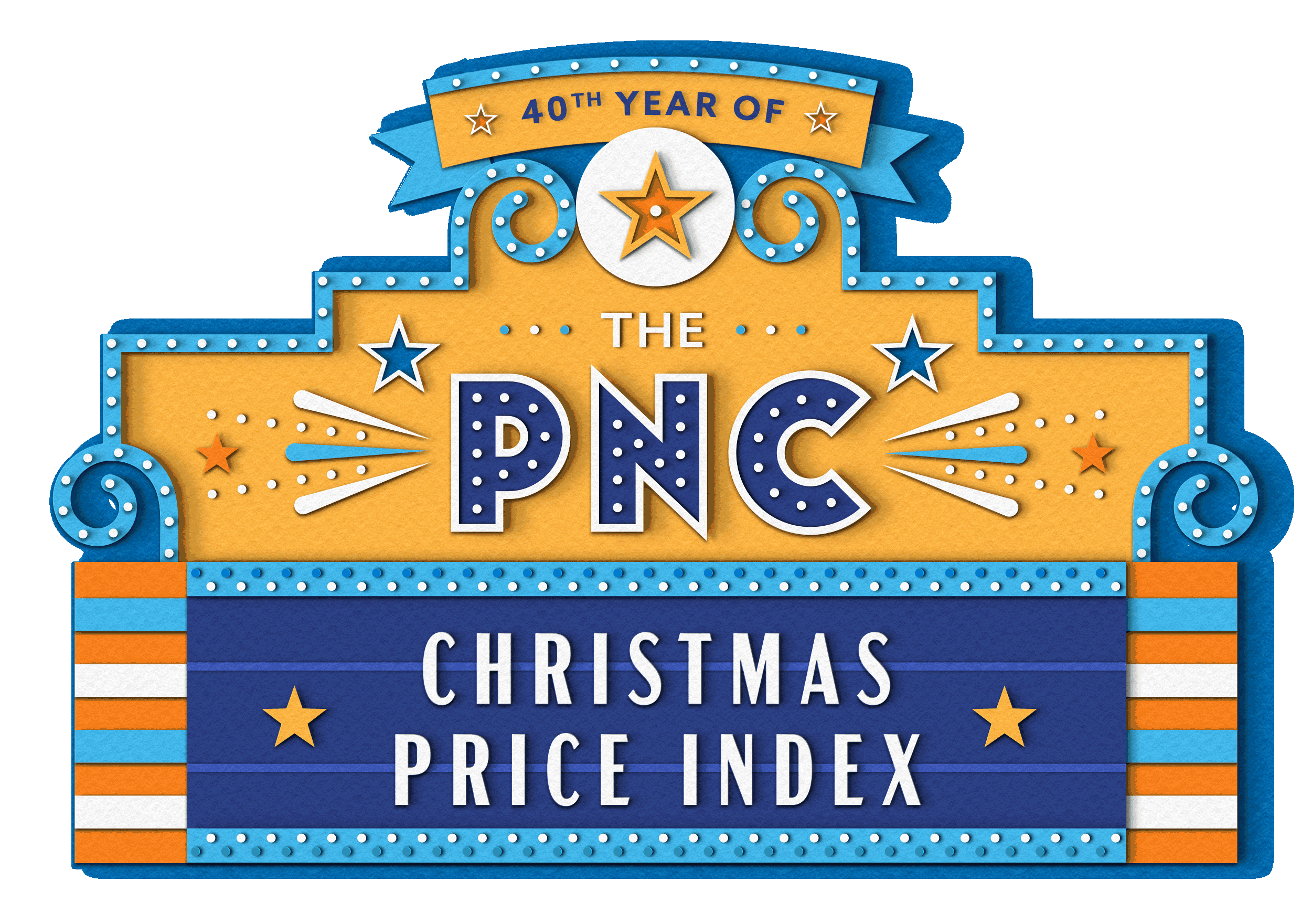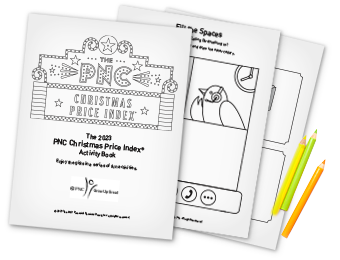"PNC Christmas Price Index" and "Christmas Price Index" are registered marks of The PNC Financial Services Group, Inc

For 40 years, PNC has calculated the prices of the 12 gifts from the classic song, "The Twelve Days of Christmas." The PNC Christmas Price Index® remains a whimsical holiday tradition.

TOTAL CHRISTMAS PRICE INDEX (CPI)
Even with its small basket of goods and services, the PNC Christmas Price Index is not immune to the rising costs in the broader U.S. economy, as measured by the Bureau of Labor Statistics’ Consumer Price Index.
$46,729.86
(+2.7%)
On the First Day of Christmas, My True Love Gave to Me...
A Partridge in a Pear Tree
$319.18
(+13.9%)
Rents are rising again for the Partridge in 2023. The price of the bird stayed flat, but the tree it lives in grew by 15%, reflecting overall growth in housing costs.





Two Turtle Doves
$750.00
(+25.0%)
The Turtle Doves are the most volatile gift in the index this year, growing by 25% in price. Their cost increase reflects their rarity.

Three French Hens
$330.00
(+3.5%)
The French Hens grew modestly in price this year, due to rising labor and energy costs. They’re still among the most affordable birds in the index at just $330.


Four Calling Birds
$599.96
(0.0%)
It’s easy to budget for the Four Calling Birds. They’re the same price as they were last year. And the year before that, and the year before that, and …

Five Gold Rings
$1,245.00
(0.0%)
Gold never goes out of style, but apparently plain gold bands do. The price for Five Gold Rings stayed flat for the first time in more than five years.


Six Geese-A-Laying
$780.00
(+8.3%)
Inspired by their very expensive swan cousins, the Six-Geese-a-Laying have been on a growth run in recent years. Since 2018 they’ve grown in total price by almost $500.

Seven Swans-A-Swimming
$13,125.00
(0.0%)
The good news for True Love is that the price of Seven Swans-a-Swimming, which has been the most volatile gift, stayed flat year to year. The bad news is they still cost $13,125 – the second most expensive price tag in the index.


Eight Maids-A-Milking
$58.00
(0.0%)
The Eight Maids-A-Milking reflect the Federal Minimum Wage, which remains unchanged this year. Therefore, the maids are available for $58 this holiday season.

Nine Ladies Dancing
$8,308.12
(0.0%)
The price of Nine Ladies Dancing rose by a hefty 10% in 2022 – their first increase in almost a decade. The price to hire a dance company stayed flat this year, though.


Ten Lords-A-Leaping
$14,539.20
(+4.0%)
Let’s hear it for the 10 Lords-a-Leaping. They’re the most expensive gift in the index, holding off the stagnant swans with another 4% increase in 2023.

Eleven Pipers Piping
$3,207.38
(+6.2%)
If you’d like to hear a piper pipe, get ready to pay for it. A tight labor market means a 6.2% increase in the cost for these musicians.


Twelve Drummers Drumming
$3,468.02
(+6.2%)
Faced with the same labor conditions as the pipers, the Twelve Drummers Drumming are setting the beat for a 6.2% increase in price for their services in 2023.

True Cost of Christmas in Song
$201,972.66
(+2.5%)
This represents the total cost of all the gifts bestowed by True Love when you count each repetition of the song, totaling 364 presents. Spreading cheer throughout the year in 2023 costs 2.5% more than in 2022.
"Core" Index (Excluding Swans)
$33,604.86
(+3.7%)
This version of the CPI removes the most volatile gift from the index - the Swans-a-Swimming.
About the Index
The PNC Christmas Price Index® is an annual tradition which shows the current cost for one set of each of the gifts given in the song "The Twelve Days of Christmas."
It is similar to the U.S. Consumer Price Index, which measures the changing prices of goods and services like housing, food, clothing, transportation and more that reflect the spending habits of the average American.
The goods and services in the PNC Christmas Price Index® are far more whimsical, of course. And most years, the price changes closely mirror those in the U.S. Consumer Price Index.
It’s a fun way to measure consumer spending and trends in the economy. So, even if Pipers Piping or Geese-a-Laying didn’t make your gift list this year, you can still learn a lot by checking out why their prices have increased or decreased over the years.
It all started 40 years ago at a PNC predecessor bank in Philadelphia as a way to engage clients during the traditionally light holiday weeks. What hatched as the creative brainchild of the bank’s then-chief economist has since grown into one of PNC’s most popular and anticipated economic reports.
Over the years, trends have emerged, and the PNC Christmas Price Index® (PNC CPI) has often increased or decreased at a rate consistent with the U.S. Consumer Price Index, a measure of inflation produced by the U.S. Department of Labor.
Here are some factoids from the last 40 years:
- The price of services overall has increased, while the price of goods has slowed. This is a flip from 40 years ago, when prices for the cost of goods were much higher than services, which mirrors the trend in the U.S. economy. In the PNC CPI, goods are represented by the birds and the gold rings, while services are the entertainers and the maids.
- Since the PNC CPI launched, the Consumer Price Index has increased 191% while the PNC CPI increased 133%. The methodology differences are obviously going to given distinct results, but the overall inflation trends have remained remarkably consistent
over the years. - $4.14 — The price difference of the Seven Swans-a-Swimming between 1984 and today. Every single gift in the index has risen in price, but one of the most expensive is also the least changed from its debut. The swans debuted at $13,120.86 in 1984, and are priced at $13,125 in 2023. This, despite the swans being a volatile component, changing in price at least 10% seven times in the index’s history.
- 50% — The price drop those same swans experienced in 1995. Due to a successful domestic Trumpeter Swan breeding program, the prices of swans tumbled by 50% that year and fell even further to a paltry $3,936 in 2002, before steadily climbing to today’s price of $13,125.
- $2,400 — Dollar for dollar, the four entertainment industry gifts (Ladies, Lords, Pipers and Drummers) have seen the biggest price increases and are most responsible for the CPI’s growth over the years. Each of the four gifts has grown by at least $2,400 from
their debut in 1984. - $2,903 — The debut price for the Ten Lords-a-Leaping in 1984. They have leaped in price by a staggering $11,635 since then.
- 8 — The number of times the Four Calling Birds have changed prices in the history of the index. Ever a model of consistency from the inception of the index, the birds pricing remained the same for 17 years before their first modest increase.
- $15 — The debut price of the Three French Hens. The trio stayed at that price for almost
20 years. - 233% — The percentage price increase those same hens jumped in 2010 — it’s the largest one-year percentage increase for a single gift in the history of the index. They jumped from $45 in 2009, to $150 the following year.
- 2003 — The year the CPI overall experienced its biggest jump in total price. The CPI grew by 18.4% that year on the backs of significant price increases to the Calling Birds, Swans, Pipers and Drummers.
- 4 — The number of times the index has experienced a drop in total price year over year. One of the most dramatic was in 1995, when the index dipped by 26.4% on significant drops in the housing market, gold, and the aforementioned 50% drop in the price of the swans. That year was eclipsed by only…
- 2020 — The year that saw the single biggest percentage drop in the index (58.5%) as well as the lowest overall price of the index (only $16,168.14.) That version of the CPI did not include any of the four entertainment-related gifts, due to pandemic restrictions on in-person performances.
All Gifts
| 1984-1993 | 1984 |
1985 |
1986 |
1987 |
1988 |
1989 |
1990 |
1991 |
1992 |
1993 |
|---|---|---|---|---|---|---|---|---|---|---|
| 1994-2003 | 1994 |
1995 |
1996 |
1997 |
1998 |
1999 |
2000 |
2001 |
2002 |
2003 |
| 2004-2013 | 2004 |
2005 |
2006 |
2007 |
2008 |
2009 |
2010 |
2011 |
2012 |
2013 |
| 2014-2023 | 2014 |
2015 |
2016 |
2017 |
2018 |
2019 |
2020 |
2021 |
2022 |
2023 |
What’s the difference between the Total Cost of Christmas and the True Cost of Christmas? Who figures out the prices for the PNC Christmas Price Index? The answers to all these questions and more can be found here.
What is the Christmas Price Index®, anyway?
The PNC Christmas Price Index (PNC CPI) shows the current cost for one set of each of the gifts given in the song, “The Twelve Days of Christmas."
What is the "True Cost of Christmas?"
The True Cost of Christmas is the cumulative cost of all the gifts when you count each repetition in the song, reflecting the cost of 364 gifts. This cost has measured even wider fluctuations over the years.
Why did PNC start tabulating the Christmas Price Index®?
It all started 40 years ago as a way to engage clients of PNC’s predecessor, Provident National Bank in Philadelphia, during the traditionally light holiday weeks. What hatched as the creative brainchild of the bank’s then-chief economist has since grown into one of PNC’s most popular and anticipated economic reports.
Who is the holiday shopper at PNC?
Since 1986, Rebekah McCahan of PNC Asset Management Group's Investment Office has handled our shopping duties, putting a price tag on French hens, maids-a-milking, gold rings and all the other items in the PNC CPI. She has evaluated some distinctive economic trends along the way.
Where does McCahan do her shopping?
The partridge and dove prices came from a national bird supplier. Hatcheries provided the cost of the hens and swans. The price of the geese came from a waterfowl farm. A national pet chain provided the price of the calling birds, or canaries. The pear tree price came from a Pennsylvania nursery. A national jewelry chain provided the cost of five 14-carat gold rings, and PHILADANCO, a modern dance company in Philadelphia, offered the price of ladies dancing, while Philadelphia Ballet supplied the cost of the Lords-a-Leaping. Maids-a-milking are the only unskilled laborers in the PNC CPI and, as such, they reflect the federal minimum wage. Year after year, the sources for the prices remain the same for the most part for consistency, but they have changed on occasion due to changes in the market or business landscape.
What has changed since 1984?
Many things. First, the Internet. Today, it’s easier for us to find the goods and services listed in the song online. This convenience comes at a price, however: goods and services from the survey that are purchased online tend to be more expensive than those purchased in a more traditional transaction, mainly due to added shipping and handling costs of the specialty items. In 2015, we adjusted the current prices of the turtle doves and swans to better reflect open market pricing, and revised the historical data to correlate. Second, over the last 40 years, the price of services in general has increased, while the price of goods has slowed. In the 1984 PNC CPI, goods were by far the more expensive component of the Index — today it’s services. Since 1984, the PNC CPI has increased 133%. Also related to services, in 2007, federal laws increased the minimum wage and gave the maids-a-milking their first raise since 1997. The wage increased again in both 2008 and 2009, and is now holding steady at $7.25 per hour. Third, fuel costs. As fuel prices go up and down, they have a major effect on the cost of shipping.
In which year could a shopper afford to be a scrooge?
The cheapest PNC Christmas Price Index® in dollars occurred in 1995, when the cost of Christmas was just under $15,600[1].
In 2021, why did PNC compare data with 2019 and not 2020?
Comparing 2019 data was a better gauge of the impacts of inflation before the pandemic’s effects took hold of the global economy. We "normalized" the comparison by excluding a-once-in-a-century pandemic that had an outsized impact on 2020's data.
Why did the 2020 CPI change so drastically?
Taking into account the impact of social distancing, PNC calculated the 2020 price tag for the PNC CPI at just $16,168.10, a considerable decrease of $22,825.45 or -58.5% from the 2019 cost, with a third of the index constituents literally not available for purchase. The biggest impact was for live performances, which were mostly unavailable. While some performing arts groups found ways to engage, such as through virtual presentations, it was a silent night at most symphonies and the lights dimmed on many dance companies, as reflected in 2020’s significant drop in PNC’s CPI data.
THE 2023 CHRISTMAS PRICE INDEX Activity Book
Enjoy all 12 gifts in a flurry of fun activities
Learning is fun, especially when combined with the twelve days of Christmas. Enjoy these fun activities that include counting, tracing, matching and more
Since 2004, PNC Grow Up Great® has been helping children from birth through age five develop a passion for learning that lasts a lifetime.
Insights
Markets & Economy
PNC’s Christmas Price Index By the Numbers
Celebrating 40 years of PNC’s whimsical holiday tradition as True Love’s personal shopper
4 min read
Markets & Economy
PNC’s Christmas Price Index Shows Modest Climb on Back of Inflation
Services continue to drive increases in the index, now in its 40th year
3 min read
Spend
How To Avoid A Holiday Credit Hangover
The holidays are upon us. Here’s how to make the most of them—without the Ghost of Christmas Past haunting your January credit card statement.
3 min read














